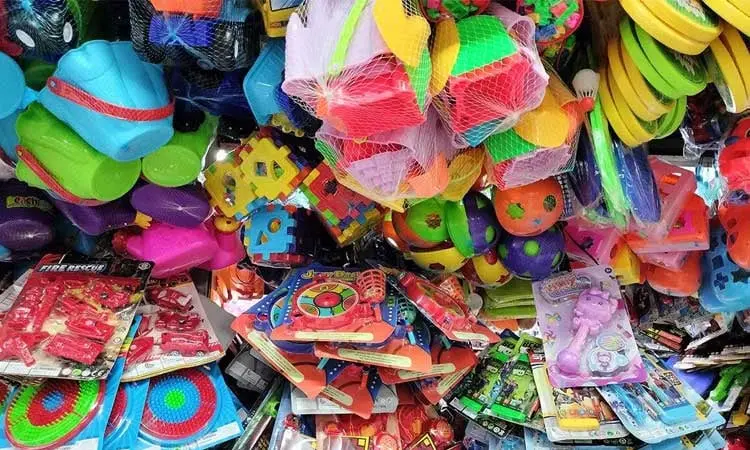
ELEVEN years since it was enacted on September 3, 2013 and five years after its implementing rules and regulations (IRR) were belatedly issued in 2019, Republic Act No. 10620, or the Toy and Game Safety Labeling Act, remains poorly implemented.
The environmental and health watchdog group EcoWaste Coalition finds it deeply concerning that the overwhelming majority of toys sold in the market are poorly labeled depriving consumers of essential information to enable them to make informed choices when purchasing toys for kids.
Based on the group’s periodic toy safety monitoring, especially during the opening of classes and during the “ber” months leading up to Christmas, toys sold by various dealers, including online sellers, lack the labeling information required by RA 10620.
For example, the 45 assorted toys purchased by the group last July 2024 from stores outside public elementary schools in eight cities of Metro Manila were either inadequately labeled or not labeled at all. Twenty of these toys pose choking hazards and some may cause accidental cuts, lacerations, eye injuries or chemical exposures.
For the EcoWaste Coalition, the overall objective of RA 10620 to ensure the safety of toys and games in the Philippines is still unfulfilled. Thus the need for a participatory process to determine the reasons for the implementation gaps and the actions that should be pursued to protect children from unsafe toys.
According to RA 10620’s IRR, toys and games within the scope of the law are required to provide the following labeling information, which shall be generally written in English: 1). License to Operate (LTO) number as issued by the Food and Drug Administration (FDA); 2) age grading; 3) cautionary statements or warnings; 4) instructional literature; 5) manufacturer’s markings; and 6) item, model, stock keeping unit (SKU) number.
The above labeling requirements are to be embossed on, directly printed, appeared on, or affixed to the package, container, wrapper, or protective coverings of the product. The label shall be in a visible, easily legible, understandable and indelible form as required by law.
R.A. 10620 provides for the removal from the market of toys and games that do not adhere to the labeling and packaging requirements. Such non-compliant toys and games shall be considered misbranded or banned hazardous substances, and shall be withdrawn from the market at the expense of the manufacturer, importer, wholesaler or distributor.
Toys and games found to be in violation of R.A. 10620 shall be confiscated, forfeited and disposed of in accordance with the law.
For the guidance and protection of consumers, RA 10620’s IRR requires the Department of Health (DOH) to publish every six months or as necessary all misbranded or banned hazardous substances intended to be sold, offered for sale or distributed.
It also requires the Department of Trade and Industry (DTI) to publish every six months or as necessary the information provided by the FDA on all manufacturers, importers, distributors and retailers who failed to comply with the requirements of law.
Under the said law, toy manufacturers, importers, distributors and retailers found in violation of RA 10620 and its IRR will be fined not less than P10,000 but not more than P50,000, or imprisoned for not less than three months but not more than two years, or both, at the discretion of the court. The criminal penalties shall be without prejudice to administrative sanctions, which the DOH may impose.
As stated in Section 2 of RA 10620: “The State recognizes that children, by reason of their physical and mental immaturity, need special safeguard and care... The State shall ensure the protection of children against potential hazards to their health and safety by requiring special labeling of toys and games. To guarantee the rights of children to protection and safety, the State shall provide a means of redress for violation of said rights.”
After their repeated demands for the promulgation of the IRR went unheeded, the EcoWaste Coalition and Laban Konsyumer Inc., together with 20 mothers as petitioners, filed a petition for writ of mandamus on October 23, 2018 at the Quezon City Regional Trial Court to direct the DTI and DOH to immediately release the law’s IRR.
After a long delay of 2,074 days, the IRR of RA 10620 was finally signed on January 20, 2019 by then Health Secretary Francisco Duque III and Trade and Industry Secretary Ramon Lopez. It took another 109 days to get the IRR published on May 9, 2019 in newspapers of national circulation.
To promote compliance to RA 10620, the FDA issued Advisory No. 2020-2022 on November 25, 2020 reiterating the mandatory labeling requirements for toys and childcare articles.
To recall, a pioneering study on toys sold in the local market conducted in July 2011 by the EcoWaste Coalition and the International Pollutants Elimination Network (IPEN) found 29 percent of 200 toys laden with harmful substances such arsenic, cadmium, chromium, lead and mercury above levels of concern. None of the samples had labeling information about their chemical composition, and many had no cautionary statements. Subsequent studies revealed the prevalence of more unsafe toys in the market, which can pose chemical, choking, flammability, laceration, strangulation and other health and safety hazards, especially among young children.
Legislators took notice of the problem and filed pertinent bills to address toy safety issues, including Senate Bill 3367 and House Bill 6529, to protect children from unsafe toys through mandatory safety labeling requirements. PR